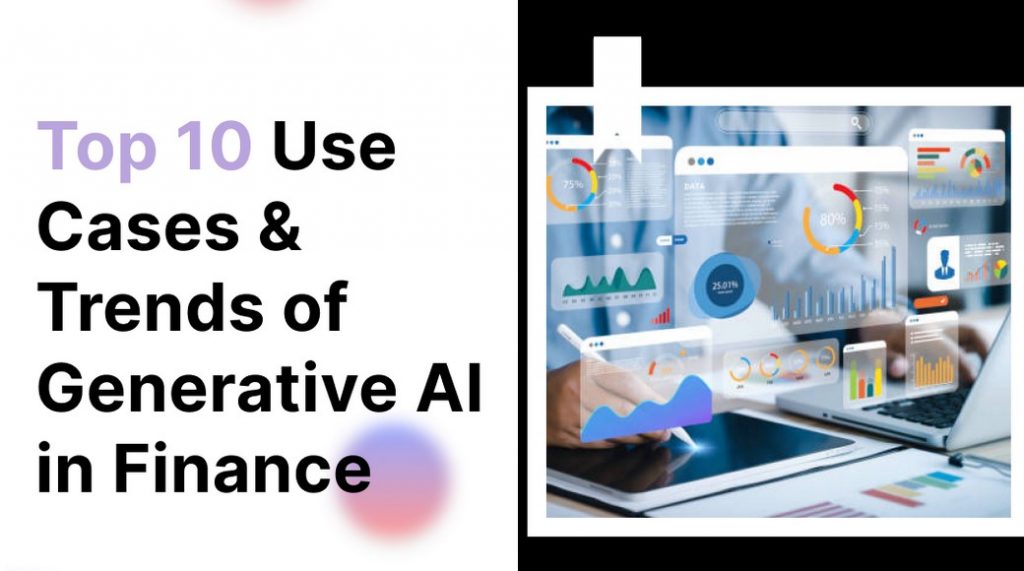Are you finding it challenging to keep up with the rapid advancements in generative AI within the financial services industry? As generative AI continues to evolve, it’s transforming the operations of financial institutions at an unprecedented pace, making it more crucial than ever to stay ahead.
Professionals in the finance and banking sectors face the challenge of dealing with vast, complex, and sometimes outdated data. Without effective management, this overload of information can result in costly errors. It can have severe consequences such as missed opportunities in financial decision-making and strategy development. This situation underlines the need for strong analytical tools and existing systems that can effortlessly process and bring in crucial insights to support informed financial actions.
This comprehensive guide will decode the real-world applications and emerging trends of generative AI solutions in the financial sector. We will share proven strategies and mindful insights that can help you utilize the massive power of generative AI to innovate, optimize, and stay ahead in the competitive financial services industry.
- What is the role of Generative AI in Financial Services?
- 10 Use Cases of Generative AI in Financial Services
- 1. Dynamic Risk Assessment Models
- 2. Generative AI for Scenario Analysis and Stress Testing
- 3. Automated Regulatory Compliance
- 4. Personalized Financial Planning Services
- 5. Enhanced Fraud Detection Systems
- 6. Generative AI-Driven Credit Scoring Models
- 7. Automated Document Processing and Analysis
- 8. Real-Time Personalized Marketing Campaign
- 9. Sophisticated Algorithmic Trading Strategies
- 10. Interactive Financial Education Tools
- Trends of Generative AI in Financial Services
- Will Generative AI Replace Bankers in Financial Services?
- Challenges in Implementations of Generative AI in Financial Services
- Best Practices for Generative AI in Financial Services
- The Bottom Line
What is the role of Generative AI in Financial Services?
Generative AI is not just leveling up the creative industries but also supporting the financial services sector. It is doing this by empowering efficiency and accuracy. It also supports personalized customer experiences in the finance and banking domain. According to a PwC report, AI will contribute up to $15.7 trillion to the global economy by 2030 with financial services among the top beneficiaries.
Generative AI is an impactful technology that supports major operations in the financial sector through progressive AI models like GPT or Generative Pre-trained Transformer and BERT or Bidirectional Encoder Representations from Transformers. They excel in understanding and generating human-like text for customer service and document analysis. Moreover, AI-driven tools like DALL-E are instrumental in creating realistic synthetic data for training and testing financial prototypes without compromising sensitive information.
By automating complex tasks, such as risk assessment and compliance reporting, AI and Generative AI not only reduce operational costs by up to 40% but also significantly cut human errors. It delivers a solid competitive edge to forward-thinking institutions in this rapidly evolving industry.
10 Use Cases of Generative AI in Financial Services
1. Dynamic Risk Assessment Models
Generative AI is leveling up risk management in financial services by developing dynamic risk assessment models. These models use historical and real-time data to foresee potential risks and outcomes more accurately. For example, Generative AI can simulate various economic scenarios to assess the impact on credit portfolios. This helps institutions adjust their strategies proactively. This use case not only enhances the ability to cut risks but also upgrades financial product offerings to suit altering market conditions.
2. Generative AI for Scenario Analysis and Stress Testing
In financial services, generative AI is used to perform advanced scenario analysis and stress testing. This use case includes AI systems developing a vast array of economic and financial scenarios to test the resilience of financial portfolios under different stress conditions. By simulating potential future crises which mainly include drastic economic downturns and market crashes plus sometimes geopolitical conflicts, Generative AI helps financial institutions understand potential impacts on their assets and liabilities. This predictive capability helps banks and financial firms to modify their strategies proactively which ensures they maintain robustness and compliance with regulatory requirements for financial stability.
3. Automated Regulatory Compliance
In the heavily regulated financial sector, generative AI is emerging as a big and impactful player in ensuring compliance. By developing reports and auditing records in real time, generative AI technologies facilitate and simplify the compliance process. It significantly cuts the likelihood of human error and the labor-intensive work of compliance teams. Financial institutions can thus guarantee they stay ahead of regulatory changes and avoid hefty fines that make compliance operations both cost-effective and robust.
4. Personalized Financial Planning Services
Generative AI encourages the creation of highly personalized financial planning and advisory services. It has the power to analyze vast amounts of data sets. These datasets include spending habits and financial goals. Generative AI also helps generate customized investment strategies and savings plans. This level of personalization not only upgrades customer satisfaction and retention but also empowers clients to make better-informed financial decisions tailored to their unique situations.
5. Enhanced Fraud Detection Systems
The financial services industry benefits from generative AI through advanced fraud detection systems. By learning from transaction patterns and customer behavior data, AI models can develop insights to identify and flag unusual activities indicative of fraud. This proactive approach not only reduces financial losses but also protects customer trust and enhances the security of financial transactions.
6. Generative AI-Driven Credit Scoring Models
Generative AI is changing the credit scoring process by developing more accurate and inclusive models. These smart generative AI systems analyze traditional and non-traditional data sources which include social media activity, utility payments, and mobile phone usage patterns, to generate credit scores. This broader data analysis helps financial institutions extend credit to underserved markets and individuals with thin credit files. It eventually enhances financial inclusion and expands market reach.
7. Automated Document Processing and Analysis
In the document-heavy environment of financial services, generative AI helps streamline document processing. By generating and analyzing key document elements such as legal contracts, loan agreements, and compliance paperwork, generative AI decreases processing times and errors. This automation speeds up decision-making procedures which enriches customer experiences during loan applications and ensures greater accuracy in compliance and regulatory documentation.
8. Real-Time Personalized Marketing Campaign
Utilizing generative AI, financial institutions can curate highly personalized marketing campaigns that adapt in real-time. By examining customer data streams, generative AI models generate tailored product offers and messages at the optimal time across various channels. This capacity not only boosts the effectiveness of marketing efforts but also significantly enhances customer engagement and multiplies conversion rates.
9. Sophisticated Algorithmic Trading Strategies
In the investment banking and asset management domain, generative AI develops sophisticated trading algorithms. These algorithms can predict market trends and execute trades at superhuman speeds. These AI-generated strategies consider a multitude of variables which includes global economic indicators and social media sentiments, to optimize trading decisions and increase portfolio return.
10. Interactive Financial Education Tools
Generative AI is extensively being used to create interactive and personalized financial education tools. These tools adapt to the learning pace and style of individual users. They generate customized learning modules and realistic simulations based on the user’s financial knowledge and goals. It further improves financial literacy and empowers users to make informed financial decisions.
Trends of Generative AI in Financial Services
-
Rise of AI in Cybersecurity Defenses
A swinging trend in the Generative AI and finance sector is to simulate potential cybersecurity threats and develop defensive strategies. This proactive approach assists institutions guard sensitive financial data and conserve trust with their customers.
-
Integration with Blockchain Technology
There is a thriving trend of combining generative AI with blockchain technology to enrich security and transparency in financial transactions. Generative AI models are being used to automate and optimize smart contract operations. They help verify the integrity of blockchain transactions and improve anti-money laundering (AML) practices.
-
AI in Quantitative Finance
Generative AI is also gaining usage in quantitative finance to generate trading models that can foresee stock movements and recognize investment opportunities based on historical data. This trend is remaking asset management by facilitating sophisticated algorithmic trading strategies.
-
Enhanced Regulatory Technology (RegTech)
Financial institutions are embracing generative AI in regulatory technology to deal with the increasing complexity and volume of financial regulation. Generative AI is used for generating compliance reports and predicting regulatory risks. It also helps in automating the management of regulatory changes and making compliance more efficient and less prone to errors.
-
Synthetic Data Generation for Testing
Generative AI is crucial in developing synthetic data that mimics real financial data. This helps banks and financial institutions to experiment with new applications and systems in a risk-free environment. It guarantees software reliability and performance under various scenarios. It also aids in stress testing and scenario analysis without the need to use sensitive customer data by maintaining privacy and security.
Will Generative AI Replace Bankers in Financial Services?
The prospect of generative AI replacing bankers in financial services is a topic of substantial debate. While Generative AI is going to automate many routine tasks which include data processing, transaction handling, and customer inquiries, the complete replacement of bankers is not possible. The role of generative AI is better viewed as augmentative rather than purely substitutive. Bankers bring irreplaceable human elements to the table which are: complex decision-making, relationship management, and ethical judgment, which are difficult to fully encode into Generative AI systems.
Further, the interpersonal aspects of banking, such as negotiating with clients and understanding unique customers need a deep level of emotional intelligence that AI cannot replicate. Therefore, generative AI will upgrade many aspects of the banking industry by making operations more efficient. It will more likely level up and reshape banker roles than replace them entirely.
The future of banking seems to lean towards a hybrid model where generative AI enriches the efficiency and capabilities of human bankers rather than rendering them jobless.
Challenges in Implementations of Generative AI in Financial Services
- Data Privacy and Security Concerns: Implementing generative AI in financial services has major roadblocks to data privacy and security. Financial institutions deal with sensitive data and providing the confidentiality and integrity of this data is crucial. Regulatory compliance with laws like GDPR and HIPAA puts in another layer of complexity.
- Bias and Fairness Issues: Generative AI systems can inadvertently perpetuate or intensify biases present in the training data. In financial services, this can lead to one-sided treatment of customers in lending and insurance underwriting. It can further disrupt customer service potentially leading to reputational damage and legal issues.
- Integration with Legacy Systems: Many financial institutions operate on legacy systems that are not readily compatible with the latest Generative AI technologies. Incorporating advanced AI tools into these systems without affecting existing operations poses a significant technological challenge.
- Scalability and Performance: As financial institutions strive to implement generative AI at scale, they face stiff challenges related to system performance. These challenges include managing large volumes of transactions and interactions in real-time while conserving accuracy and efficiency.
- Ethical and Regulatory Compliance: Navigating the ethical implications of generative AI and staying compliant with the latest regulatory standards is another constant challenge. Financial services firms must guarantee that their AI generative solutions stick to ethical guidelines and regulatory requirements to avoid penalties and strengthen public trust.
Best Practices for Generative AI in Financial Services
- Robust Data Governance: Setting strict data governance policies is essential to address privacy, security, and quality concerns. Financial institutions should execute rigorous data access controls and auditing mechanisms to provide data integrity and compliance with global data protection regulations.
- Bias Mitigation Strategies: To counteract biases in generative AI models, it is important to employ diverse datasets and regularly update and audit models to guarantee fairness and accuracy. Training teams on the significance of unbiased data collection and model testing is also crucial.
- Phased Integration Approach: Gradually integrating generative AI technologies with legacy systems can undervalue disruption. Starting with pilot projects that can provide quick wins will help in comprehending the technology’s impact and preparing for wider deployment.
- Scalability Planning: Ensuring the generative AI systems are scalable and can handle the increasing data and transaction volumes is the key. Employing cloud solutions and high-performance computing resources can further help satisfy the demands of large-scale and complicated implementations.
- Continuous Compliance Monitoring: Financial institutions should set a framework for ongoing compliance monitoring to adapt to regulatory changes promptly. Using generative AI to monitor compliance and predict regulatory trends can also be beneficial.
The Bottom Line
As we immerse deeper into the role of Generative AI in financial services, it is clear that this technology is not just a fleeting trend but a cornerstone for future innovations in the sector. Financial institutions using generative AI app development services are going to revamp their operations by enhancing everything from customer interactions and fraud detection to compliance and risk management.
By adopting these advanced generative AI solutions, banks and other financial entities can not only simplify their processes but also offer more personalized and efficient services. They eventually help in securing a competitive edge in a rapidly evolving marketplace. Be it through creating more accurate predictive models or offering bespoke financial advice, generative AI is undoubtedly shaping the future of financial services by making it an indispensable tool for those looking to thrive in this dynamic industry.



